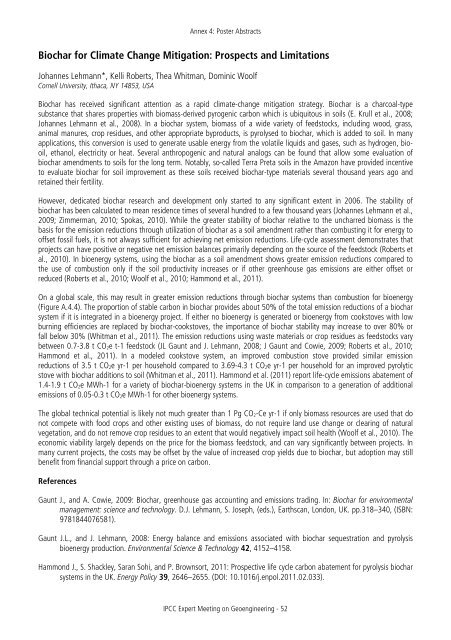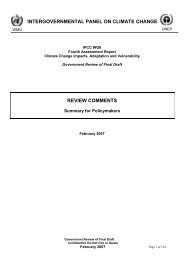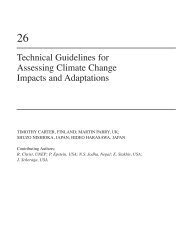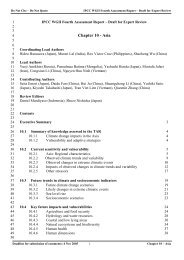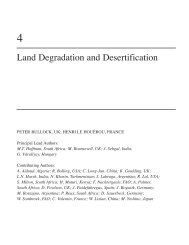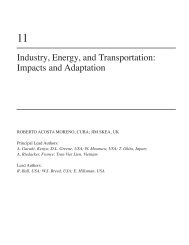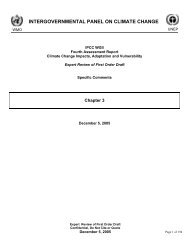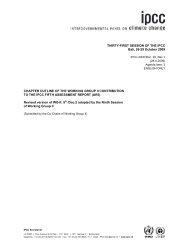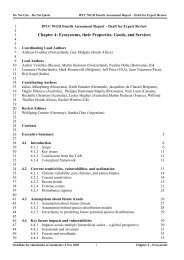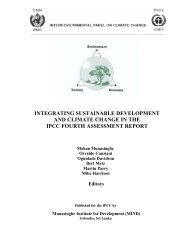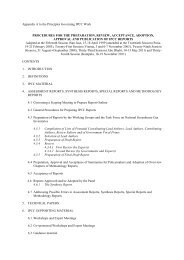IPCC Expert Meeting on Geoengineering
IPCC Expert Meeting on Geoengineering
IPCC Expert Meeting on Geoengineering
You also want an ePaper? Increase the reach of your titles
YUMPU automatically turns print PDFs into web optimized ePapers that Google loves.
Annex 4: Poster Abstracts<br />
Biochar for Climate Change Mitigati<strong>on</strong>: Prospects and Limitati<strong>on</strong>s<br />
Johannes Lehmann*, Kelli Roberts, Thea Whitman, Dominic Woolf<br />
Cornell University, Ithaca, NY 14853, USA<br />
Biochar has received significant attenti<strong>on</strong> as a rapid climate-change mitigati<strong>on</strong> strategy. Biochar is a charcoal-type<br />
substance that shares properties with biomass-derived pyrogenic carb<strong>on</strong> which is ubiquitous in soils (E. Krull et al., 2008;<br />
Johannes Lehmann et al., 2008). In a biochar system, biomass of a wide variety of feedstocks, including wood, grass,<br />
animal manures, crop residues, and other appropriate byproducts, is pyrolysed to biochar, which is added to soil. In many<br />
applicati<strong>on</strong>s, this c<strong>on</strong>versi<strong>on</strong> is used to generate usable energy from the volatile liquids and gases, such as hydrogen, biooil,<br />
ethanol, electricity or heat. Several anthropogenic and natural analogs can be found that allow some evaluati<strong>on</strong> of<br />
biochar amendments to soils for the l<strong>on</strong>g term. Notably, so-called Terra Preta soils in the Amaz<strong>on</strong> have provided incentive<br />
to evaluate biochar for soil improvement as these soils received biochar-type materials several thousand years ago and<br />
retained their fertility.<br />
However, dedicated biochar research and development <strong>on</strong>ly started to any significant extent in 2006. The stability of<br />
biochar has been calculated to mean residence times of several hundred to a few thousand years (Johannes Lehmann et al.,<br />
2009; Zimmerman, 2010; Spokas, 2010). While the greater stability of biochar relative to the uncharred biomass is the<br />
basis for the emissi<strong>on</strong> reducti<strong>on</strong>s through utilizati<strong>on</strong> of biochar as a soil amendment rather than combusting it for energy to<br />
offset fossil fuels, it is not always sufficient for achieving net emissi<strong>on</strong> reducti<strong>on</strong>s. Life-cycle assessment dem<strong>on</strong>strates that<br />
projects can have positive or negative net emissi<strong>on</strong> balances primarily depending <strong>on</strong> the source of the feedstock (Roberts et<br />
al., 2010). In bioenergy systems, using the biochar as a soil amendment shows greater emissi<strong>on</strong> reducti<strong>on</strong>s compared to<br />
the use of combusti<strong>on</strong> <strong>on</strong>ly if the soil productivity increases or if other greenhouse gas emissi<strong>on</strong>s are either offset or<br />
reduced (Roberts et al., 2010; Woolf et al., 2010; Hamm<strong>on</strong>d et al., 2011).<br />
On a global scale, this may result in greater emissi<strong>on</strong> reducti<strong>on</strong>s through biochar systems than combusti<strong>on</strong> for bioenergy<br />
(Figure A.4.4). The proporti<strong>on</strong> of stable carb<strong>on</strong> in biochar provides about 50% of the total emissi<strong>on</strong> reducti<strong>on</strong>s of a biochar<br />
system if it is integrated in a bioenergy project. If either no bioenergy is generated or bioenergy from cookstoves with low<br />
burning efficiencies are replaced by biochar-cookstoves, the importance of biochar stability may increase to over 80% or<br />
fall below 30% (Whitman et al., 2011). The emissi<strong>on</strong> reducti<strong>on</strong>s using waste materials or crop residues as feedstocks vary<br />
between 0.7-3.8 t CO 2e t-1 feedstock (JL Gaunt and J. Lehmann, 2008; J Gaunt and Cowie, 2009; Roberts et al., 2010;<br />
Hamm<strong>on</strong>d et al., 2011). In a modeled cookstove system, an improved combusti<strong>on</strong> stove provided similar emissi<strong>on</strong><br />
reducti<strong>on</strong>s of 3.5 t CO 2e yr-1 per household compared to 3.69-4.3 t CO 2e yr-1 per household for an improved pyrolytic<br />
stove with biochar additi<strong>on</strong>s to soil (Whitman et al., 2011). Hamm<strong>on</strong>d et al. (2011) report life-cycle emissi<strong>on</strong>s abatement of<br />
1.4-1.9 t CO 2e MWh-1 for a variety of biochar-bioenergy systems in the UK in comparis<strong>on</strong> to a generati<strong>on</strong> of additi<strong>on</strong>al<br />
emissi<strong>on</strong>s of 0.05-0.3 t CO 2e MWh-1 for other bioenergy systems.<br />
The global technical potential is likely not much greater than 1 Pg CO 2-Ce yr-1 if <strong>on</strong>ly biomass resources are used that do<br />
not compete with food crops and other existing uses of biomass, do not require land use change or clearing of natural<br />
vegetati<strong>on</strong>, and do not remove crop residues to an extent that would negatively impact soil health (Woolf et al., 2010). The<br />
ec<strong>on</strong>omic viability largely depends <strong>on</strong> the price for the biomass feedstock, and can vary significantly between projects. In<br />
many current projects, the costs may be offset by the value of increased crop yields due to biochar, but adopti<strong>on</strong> may still<br />
benefit from financial support through a price <strong>on</strong> carb<strong>on</strong>.<br />
References<br />
Gaunt J., and A. Cowie, 2009: Biochar, greenhouse gas accounting and emissi<strong>on</strong>s trading. In: Biochar for envir<strong>on</strong>mental<br />
management: science and technology. D.J. Lehmann, S. Joseph, (eds.), Earthscan, L<strong>on</strong>d<strong>on</strong>, UK. pp.318–340, (ISBN:<br />
9781844076581).<br />
Gaunt J.L., and J. Lehmann, 2008: Energy balance and emissi<strong>on</strong>s associated with biochar sequestrati<strong>on</strong> and pyrolysis<br />
bioenergy producti<strong>on</strong>. Envir<strong>on</strong>mental Science & Technology 42, 4152–4158.<br />
Hamm<strong>on</strong>d J., S. Shackley, Saran Sohi, and P. Brownsort, 2011: Prospective life cycle carb<strong>on</strong> abatement for pyrolysis biochar<br />
systems in the UK. Energy Policy 39, 2646–2655. (DOI: 10.1016/j.enpol.2011.02.033).<br />
<str<strong>on</strong>g>IPCC</str<strong>on</strong>g> <str<strong>on</strong>g>Expert</str<strong>on</strong>g> <str<strong>on</strong>g>Meeting</str<strong>on</strong>g> <strong>on</strong> <strong>Geoengineering</strong> - 52


